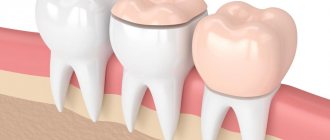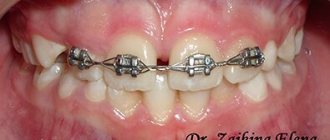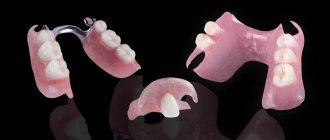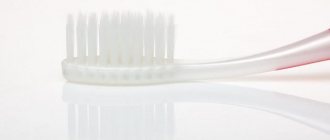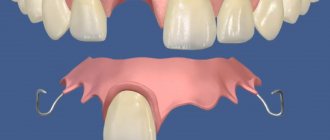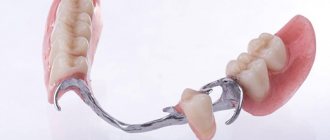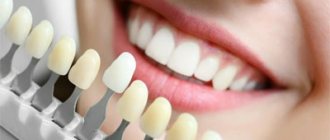Nowadays, aesthetic dentistry has come a long way. Now it allows anyone to quickly acquire a beautiful smile. We will tell you further about how to place an order for dental veneers and what they are made of.
Nowadays, everyone can truly become the owner of a beautiful smile. To do this, he only needs to install special devices called “veneers” into the oral cavity. False teeth veneers are thin, permanent overlays made from composite material, zirconium dioxide, and ceramics.
They are glued to the filed surface of the enamel with special cement. Thanks to this, a person’s front teeth become ideal, because... attachments on the upper teeth hide all external defects and imperfections. They allow the patient to quickly get rid of chips, cracks, hide unsightly shades, existing fillings, diastemas, slight curvature, and different sizes of teeth. Such products have both positive and negative qualities. Their positive qualities are as follows. Only here is the patient:
- can count on a high aesthetic result;
- practically does not injure ordinary teeth, because During the installation of a conventional crown, tooth enamel is severely damaged.
In addition to the advantages, these products also have some disadvantages. The fact is that installing veneers or special attachments on teeth is not a cheap pleasure. You will have to pay a round sum of money for them.
Remember: before installing veneers, a person’s teeth must be ground down. And after removing this device, the patient’s teeth will no longer be the same.
Types of dental inlays and their scope of application
Article navigation
- What are Tabs
- Stump and restorative
- Differences from a filling
- Differences from veneers
- Indications for use
- Contraindications
- Advantages
- What are the disadvantages
- Varieties and materials
- Manufacturing and installation
- Quality assessment parameters
- Are there any complications?
- Service life and care
- What to consider when choosing
- Current prices
Question for a specialist
Destruction of chewing teeth is a big problem for modern adults. Dietary features, the predominance of soft and sweet foods in the diet, and not always high-quality treatment of caries lead to the need for orthopedic restoration. One of the preferred methods is an inlay on the tooth, which will give it beauty and functionality for many years. Next, we will talk about what it is - an inlay for tooth restoration, what it looks like and what it is made of, how it is made, how it is placed and how much it costs.
Why do you need dental veneers?
Dental onlays make it possible to solve various dental problems; depending on the purpose of installation, they are divided into:
- Therapeutic – used to eliminate defects on the surface of teeth. Installed for cracks in the enamel, thin enamel layer, irregularly shaped teeth, or too wide interdental spaces. The service life of such products is up to five years.
- Orthopedic – placed to straighten the dentition. Budget orthopedic structures can retain their properties for up to 10–12 years, expensive lumineers for up to 20 years.
- Decorative - used as decoration. They do not have a specific service life. There are removable and non-removable decorative structures, made to order or standard stamped.
What are Tabs
Everyone knows what fillings and crowns are. But when a dentist offers such an option as dental inlays, many people do not understand what this means. Let's figure it out.
Inlays for a tooth crown (or, as they are also called, “onlays”) refer to microprosthetics when it comes to restoring a partially destroyed natural crown. Inlays are an alternative to large fillings and they are needed when, as a result of caries, the top of the tooth is severely destroyed, but it is too early to install a dental crown and cannot be restored with a filling. An inlay is literally a missing piece of tooth that is attached to the remaining walls.
OPERATIVE PROSTHETICS WITH ACRYLIC PROSTHETICS - from RUR 180,000.
Re-prosthetics with an acrylic bridge on a metal frame (all included) up to 12 units.
Save RUR 30,000. Call now or request a call
It is included in the kit
SnapOnSmile veneers are an outstanding development of professional dentists; they allow you to get instant results without expensive, exhausting procedures. They are made of durable plastic that is not felt on the teeth and does not darken from coffee, tea, or coloring liquids. The aligners are easy to remove and have a long service life.
The composition of Snap On Smile is safe, the plastic does not oxidize, the material is biodegradable in the natural environment.
Universal size, suitable for people aged 16 to 60 years.
Removable veneers Snap On Smile are sold in a set containing:
- 1 piece of veneers made of thin, durable material.
- Convenient container for storing insert aligners.
- Instructions in Russian.
Some sets have a double set - for the upper and lower jaw. Check with the manager for their availability. Toothbrush and toothpaste are not included, please purchase them separately.
Differences in purpose - stump and restorative
The topic of today's article is developing around microprosthetic inlays; they are needed to restore a natural crown and are therefore called “restorative”. Restorative ones are attached to the outside of the tooth and are visible to anyone if they open their mouth. In fact, they are alternatives to fillings.
What is an inlay for a tooth under a crown? There is another option for permanent prosthetics - this is the stump type. It is needed not for beauty, but for strength. Stumps, as the name implies, have the shape of a tooth stump. The lower part of the stump tab is inserted into the root canals, and the upper part rises slightly above the gum and serves as a support for the crown or prosthesis. Those. the stump will not be visible, no matter how you open your mouth, because it is always hidden by an artificial crown. But, in fact, it is also restorative, but it replaces not only the apex, but also the dental canals. You can read more about this type in a separate article.
How to put on perfect smile pads correctly?
Having purchased a new product, first of all you need to read the instructions on how to install Perfect Smile veneers. It is extremely important to follow clear instructions to avoid improper placement of the overlays on your teeth and gums, as well as any discomfort.
We invite you to read: Until what age can children, teenagers and adults have braces installed, which systems are best for straightening teeth?
Instructions for use of Perfect Smile Veneers:
- Preparation - place the plates in a glass of hot water for several minutes until the white coating becomes transparent;
- Shaping - we firmly press the veneers to the natural teeth to obtain the required outline of the plate;
- Hardening - immerse the veneers in cold water for a few minutes until the white coating reappears;
- Installation - we put on the plates like ordinary plug-in elements.
The versatility of Perfect Smile Veneers lies in the ability to shape the onlays identical to natural teeth.
Only with proper preparation will Perfect Smile veneers last a long time, will not cause inconvenience and wear well: they do not fall out and do not interfere with talking or eating.
Many buyers complain about the poor quality of the product, not knowing how to use veneers correctly. Therefore, we recommend watching a video on how to put on Perfect Smile Veneers:
The importance of following recommendations for installation and operation of overlays is sometimes underestimated. The quality of your future smile depends on the correct preparation and placement of the plates. Placing veneers according to the rules allows you to avoid possible difficulties and save time before an important event.
Differences from a filling
Any filling is installed using the direct method, so it can be placed on the same day you contact a specialist. Filling materials – paste or powder, mixed with liquid before filling. The filling hardens in air and under the influence of a special lamp. And the service life of even the best filling is no more than 3-4 years. Afterwards it will also stand, but you need to check the quality of the fit and its shape - it still shrinks under load.
The inlay is made by an indirect method - in a dental laboratory using casts of the jaws, or more precisely, the patient’s teeth. For such microprostheses, metals, liquid and lump ceramics, blocks of zirconium and aluminum dioxide, as well as composite compositions similar to fillings are used. These microprostheses are installed on the patient ready-made, i.e. fully formed and hardened.
Dental inlays compare favorably with conventional fillings in that they allow you to restore a badly damaged tooth for a longer period of time. For example, if deep caries was discovered, and after its treatment a large cavity formed, it is better to fill it with a microprosthesis, which is created individually in a dental laboratory. This method is more preferable, since saliva may enter when placing the filling, as a result of which the entire treatment process will be ineffective. And the patient himself is not very comfortable spending a long time in the dental chair during the formation and subsequent grinding of the filling. The inlay will also last many times longer than any composite restoration.
Veneers made from composite filling material –
Those who have made veneers from composites know that they have significant disadvantages.
You will find detailed information about the level of patient satisfaction with such veneers in the “reviews/service life” section. As we have already said, composite veneers in Russia in 95% of cases are made by dental therapists directly in the patient’s mouth, but there is also a technology for their manufacture in a dental laboratory. In fact, such a veneer is a regular filling that occupies the entire front part of the tooth. Composite veneers on the 6 upper front teeth –
The aesthetics of composite veneers are very far from the aesthetics of ceramic veneers. If you take a closer look at the before and after photos (posted just above), you will see that veneers made from composite do not have the translucency that natural tooth enamel has, and they also have a slightly unnatural milky color. However, such veneers also have undeniable advantages.
Firstly, the cost of composite veneers is at least 2-4 times lower than ceramic ones. Secondly, they can be done in just 1 visit. True, they have much more disadvantages and, of course, if you are very demanding in terms of aesthetics and reliability, then veneers made from a composite filling material are unlikely to suit you (read about the disadvantages of such veneers at the link above).
Reviews of composite veneers –
Composite veneers - service life is approximately 2-3 years or 3-4 (if you're lucky). We must remember that such “veneers” need periodic polishing, but in any case, over time they will darken and fade, and after 4-5 years they will look like this -
Study (by Wakiaga, 2004) - assessed patient satisfaction with composite veneers. It was conducted based on a survey of 200 people over a 2.5-year after they received composite veneers. The satisfaction rate was only 67%, in contrast to, for example, satisfaction with ceramic veneers (93%).
However, for the latest study it is necessary to make allowances for Russian reality. As we have already said: the quality of manufacturing composite veneers abroad is much higher, so you should not create any illusions that cheaper composite veneers will look like expensive ceramic ones.
Differences from veneers - and is it possible to put inlays on incisors and canines?
If we take into account the materials for manufacturing, then both veneers and inlays are, in principle, identical. Besides metal, metal veneers would look too shocking. Although some musical performers wear grills - removable analogues of veneers made of precious metals and stones. Some patients also call veneers ceramic inlays for the front teeth. But here the term “overlays” is still closer, because Veneers are applied to the tooth surface rather than inserted into a cavity.
The main difference is that any veneers are installed only on the anterior side of the frontal zone (incisors, canines and sometimes the first premolar) and serve only to give the smile high aesthetics. You cannot bite off hard food with veneers. And inlays are installed only on the chewing areas of the rows (premolars and molars), and on any side - the chewing surface, the lateral one. And you can chew any food with your teeth using these microprostheses.
Don't know what type of prosthetics to choose?
We will help in the selection, advise where to read more information and compare types of prosthetics.
Consultation with an orthopedic doctor in Moscow clinics is free! Call now or request a call
Working hours: from 9:00 to 21:00 - seven days a week
Reviews from doctors
Andrey Verkhovtsev, dentist. I recommend Snap On Smile veneers to patients who cannot afford surgeries and metal ceramics. They instantly mask imperfections and allow you to achieve a perfect smile at home. The undoubted advantage of these products is medical polyurethane, which does not cause side effects. If you wear veneers constantly, your bite will improve over time. I recommend removing false teeth at night and treating them well.
Sources:
- https://ViniryZub.ru/span-on-smile
- https://snaps-on-smile.ru/
- https://hudetdoma.ru/snap-on-smile-semnye-viniry/
- https://healthico.ru/teeth/snap-on-smile/
- https://24dentist.ru/vidy-protezov/snap-on-smile-novyj-metod-kachestvennogo-protezirovaniya-zubov.html
- https://doctorzhak.ru/snap-on-smile.html
- https://www.vash-dentist.ru/protezirovanie/nesemnyie-p/viniryi-np/ulyibki-s-pomoshhyu-snap-on-smile.html
- https://otzvs.com/medicine/semnye-viniry-snap-on-smile
Indications for use
- chips of the dental crown are less than 50% - that is, the side walls must remain so that the inlay can be secured. If they are not there, i.e. the crown is destroyed at the root, it is necessary to consider the stump tab,
- restoration of a natural crown after massive drilling of enamel and dentin in the treatment of caries, when the installation of a composite filling is unreliable,
- replacing old fillings with more reliable and durable solutions,
- thin tooth walls and the large cavity they surround,
- increased sensitivity to chemical and thermal irritants: cold, hot, sour, sweet.
Advantages and disadvantages of different types of veneers
The advantage of artificial onlays is the flawless recreation of the color, strength and tactile characteristics of natural teeth without the possibility of them being damaged by caries. Porcelain and ceramic veneers have the best qualities, according to dentists and patients.
They better imitate the natural surface of enamel and transmit light well, making them look natural and beautiful. These pads have a long service life if a person adheres to good oral hygiene and does not consume certain foods without proper preparation.
Composite plates are considered less durable - if not properly cared for, they can fall off prematurely and become yellow. Acrylic is also used for a short time due to the low natural effect.
Contraindications for use
If we take into account all the indications and the location of the installation, then the contraindications look like this:
- the natural crown is destroyed by more than half,
- the “nerve” has long been removed from the roots: in this case, the microprosthesis can last much less than the stated period,
- periodontitis, cysts or granulomas are found at the roots: without treatment, the pathology will continue to develop, which will inevitably lead to the need to remove the onlay and treat the periodontium/bone,
- if restoration of incisors or canines is required.
What do false teeth mask?
The creation of special veneers is based on American technology. The universal device performs two functions at once. These are liners and veneers. A dental veneer hides defects in real teeth. Improves visual appeal due to its smooth structure. When using a new overlay, the following problems are solved:
- absence of individual units in the dentition;
- ugly structure of natural teeth;
- large gaps;
- chips resulting from injury;
- bite defects;
- enamel with a yellowed or damaged layer.
People are embarrassed to smile when they have these problems. Others see this as signs of indecisiveness and tightness. Due to a dental defect, barriers to relationships with the other sex develop. It is difficult for a person to move up the career ladder. Finding a high-paying position is becoming more difficult. Having bought new veneers for 1290 rubles, a person will instantly solve the problem with his appearance.
Benefits or "success factors"
- more accurate restoration of the anatomical shape of the dental crown compared to fillings,
- strength and durability,
- high aesthetics: when using metal-free ceramics or zirconium/aluminum dioxide, the restoration looks absolutely natural,
- the inlays do not shrink, do not shrink in size, do not wear down or stain,
- unlike dental crowns, “onlays” allow you to restore only the destroyed part without grinding down healthy tissue,
- installation does not require removal of the dental “nerve” if the roots are healthy,
- the possibility of long-term strengthening of the tooth for subsequent removable or permanent prosthetics,
- very tight fit to the walls of the cavity: which eliminates the risk of caries under the microprosthesis.
Instructions for use
In addition to the installation instructions, it is necessary to take into account the manufacturer's instructions for using the Perfect Smile Veneers design. It is important to store the product correctly and promptly clean it from food residues.
We invite you to familiarize yourself with Chlorhexidine: use of solution
Basic rules when using Perfect Smile Veneers:
- The pads must be stored in a special container included with the product;
- The plates should be washed regularly for cleaning and disinfection;
- It is better to soften the veneers and give them shape immediately before installation;
- It is not recommended to attempt to use the pads for purposes other than their intended purpose;
- The plates must not be broken, bent or subjected to other traumatic effects.
When used correctly, Perfect Smile Veneers can last for many years and will not require immediate replacement.
You can wear veneers throughout the day, but at night it is recommended to remove them and wash them.
The product should be washed according to the manufacturer's instructions:
- Perfect Smile Veneers can only be washed in warm water;
- It is not recommended to use soap substances intended for hair and body;
- You should not use devices with solid particles, for example, scrubs, toothbrushes, especially with hard bristles;
- Avoid using chemicals;
- It is better to rinse the plates under running water;
- The product should dry naturally.
The best way to clean veneers is to use warm water and baking soda; you can also use toothpaste or powder, but apply them with your finger. After the procedure, the plates should be lightly blotted with a towel and left to dry in a well-ventilated area.
Popular varieties and what materials they are made from
Orthopedic dentistry has an impressive arsenal of types of inlays for teeth - there are composite, all-ceramic, all-metal, metal-ceramic and zirconium dioxide. Let's take a closer look at them.
Composite and their features
Synthetic or composite inlays are created from the same materials as fillings. They are relatively strong, durable, and fit quite tightly to the walls. The difference from fillings in this variety is that they are created from an impression in the laboratory without the presence of the patient. Such a microprosthesis fits more tightly to the dental walls than a filling. Service life is about 3-5 years.
Made from solid ceramic
A ceramic inlay1 for a tooth is made from solid ceramics, which does not contain metal, which means the product will not cause allergies. It is very aesthetic, in terms of density and external properties it is almost identical to natural enamel. The service life is about 5-7 years. Therefore, ceramic in most cases are optimal for prosthetics.
Made from zirconium dioxide or aluminum
Such products are extremely aesthetic, durable and strong, they fit exactly to the walls of the teeth, thanks to the peculiarities of the manufacturing technology (we’ll talk about this a little later). After all, materials, especially zirconium dioxide, are much stronger than ceramics or natural teeth, but the cost of zirconium dioxide/aluminum microprostheses is significantly more expensive than ceramic or composite ones. Service life is from 5-7 years.
It is important to understand that the service life of tabs is actually very conditional. In many ways, how long they last is influenced by the condition of the tooth they are restoring.
Metal and their features
A metal tooth tab is considered an outdated method of prosthetics, since precious or ordinary metals (a combination of nickel, copper, cobalt or chromium) are used here. Materials such as gold, platinum, palladium and silver do not cause allergic reactions, are very durable and strong, adhere well to the tooth surface, but do not look very attractive. Microprostheses made of conventional metals are also not aesthetically pleasing; moreover, they oxidize over time and can cause allergic reactions. The service life depends on the type of alloy, for base alloys it is about 3 years, for noble alloys it is about 7-10 years.
Metal-ceramic microprostheses
Metal-ceramic ones have a base made of ordinary metals or precious alloys and are externally coated with ceramics. This method of restoration is practically not used in orthopedic dentistry, since it has not justified itself in terms of aesthetic and functional properties. You can see how the metal-ceramic inlay should be placed on the tooth in the photo below. Metal-ceramics are very effective for dental prosthetics with crowns covering the entire surface of the tooth, but are not effective enough for partial restoration, that is, for the manufacture of inlays. Service life is about 3 years.
Preparing a tooth for a crown
In order to fix a crown or any other restoration option, the tooth must first be treated to remove carious and non-carious formations. This is done in order to prevent the development of complications after prosthetics.
The depth of treatment depends on the degree of damage to the tooth tissue and on the chosen prosthetic option. For example, if we use an all-ceramic crown, this will allow us to preserve more living tooth tissue, while using a crown based on a metal or zirconium frame requires more severe processing.
Tooth processing process
Manufacturing and installation
How to make a tooth inlay? Let's look at the ways in which modern microprostheses are created:
- creation by a dental technician manually: the orthopedist takes an impression of both jaws, selects the color of the future “onlay”, after which the dental technician makes it manually in accordance with the impressions, using appropriate equipment for processing the material at each stage of production. This is how composite products are made, partly also ceramics,
- computer modeling and CAD/CAM milling: a microprosthesis is created using high-tech equipment - first the entire oral cavity is scanned. Afterwards, a virtual model of the future prosthesis is created, taking into account the position of all teeth, and then the prosthesis is made using automated equipment from a single piece of ceramic, zirconium dioxide or aluminum oxide - the most modern, durable and aesthetic materials for dental prosthetics.
The creation of the product may take several days - during this time a temporary filling will be installed, which will protect the treated cavity from destruction and penetration of bacteria.
Before placing the inlay on the tooth, the orthopedist removes the temporary filling, processes the walls of the cavity to roughen it (to ensure better adhesion), disinfects the cavity, and then tries on the finished microprosthesis. If everything fits perfectly, then the “onlay” is fixed in the oral cavity using special dental glass ionomer cement or composites (photo- or chemical curing). The remaining cement is then ground off and the restored crown is polished to prevent bacteria and food debris from accumulating on it.
Types of materials
Dental inlays and onlays are made not only from ceramics. Metal alloys and combinations of metal and ceramics are sometimes used. But ceramic models are rightfully the most aesthetic and reliable. Modern technologies make it possible to produce safe, aesthetic and reliable structures for teeth. Not only onlays are made from ceramics, but also veneers and crowns. Ceramics are present in bracket systems. But along with all the advantages, the material has a disadvantage. This is a rather fragile material, so this option is not suitable for chewing teeth.
To produce ceramic onlays for chewing teeth, modern manufacturers use special types of ceramics that have the highest strength and reliability. Such options can be used for chewing dental units. Another disadvantage of the material is its high cost. Not every patient will be able to afford the purchase of ceramic microprostheses. On specialized websites and forums you can read reviews from patients who wear such designs. You can get acquainted with the pros and cons of the designs.
Quality assessment parameters
High-quality microprostheses must be produced with the highest precision and according to the individual parameters of a particular patient. Therefore, a good prosthesis can be made in 1-3 weeks, which includes not only the production itself, but also modeling, creating a blank, and trying it on to evaluate all the characteristics.
Complex on 4 OSSTEM implants with delayed loading - from RUB 170,000.
Complex implantation Osstem (South Korea) with delayed loading after 4-6 months.
Guarantee for the doctor’s work - unlimited Call now or order a call
Opening hours: 24 hours a day - seven days a week
Before choosing the type and material of a microprosthesis, the dentist must conduct a diagnosis. It also includes an X-ray examination to determine possible pathologies (caries, pulpitis, periodontitis, etc.). X-rays are also taken after prosthetics to assess the tightness of the fit to the walls and the absence of air cavities. By the way, during regular medical examinations the dentist can also take x-rays of the restoration - to identify the nuances and pathologies mentioned earlier.
What helps you choose the color of veneers
- Illumination
. The room should be adequately lit. Bright light encourages you to choose lighter shades, dim light encourages you to choose darker shades. - Removing plaque
. Professional teeth cleaning lightens them slightly, which affects the choice of shade. - Lack of bright colors
in the area where the selection takes place. Bright lipstick, makeup, and clothing details can disrupt color perception. - Wet surface
of teeth. The shade of moistened teeth is the most accurate.
Large clinics, such as ROOTT MCDI, use digital smile technology - Digital Smile Design
. The patient can see the results of the treatment even before it begins. This makes choosing the color of the overlays much easier and reduces frustration. If there is no such technology in dentistry, then the sample is brought to the teeth and a photo is taken to evaluate the appearance.
Are there any complications?
The most common complication is the appearance of caries in the deep tissues under the prosthesis. Detachment of the “onlay” from the dental walls, chipping of ceramics or composite (or even the walls around the denture with the development of cervical caries, for example), can also occur. Another possible complication is injury to the antagonist tooth (chip or periodontitis). Complications occur if the following mistakes are made:
- preliminary diagnosis was incomplete or carious tissue was poorly removed,
- the patient, while wearing a temporary filling, did not follow the recommendations of the orthopedist and chewed intensively on the prosthetic side,
- violation of technology when taking impressions, manufacturing, fitting and installation.
How to remove skys
It is not recommended to do this yourself - dental glue is quite strong, so you can damage the enamel. You need to see a dentist - removing the skye takes little time, and the doctor will remove any remaining glue and polish the tooth. Removing a gemstone involves subsequent filling of the hole.
It is also worth noting that if the skyce has come off (even partially), in no case should you use improvised means to secure it. This can harm your teeth and your entire body. It is worth contacting a doctor as quickly as possible to carry out a professional procedure for removing the structure.
Service life and care
The service life of composite microprostheses is several years; ceramic and “dioxide” ones can reach 10 years. Products made by milling on a robotic machine have maximum accuracy and fit to the tooth, so they last longer than usual. First of all, the service life depends on the health of the teeth, since if caries occurs deep in the cavity, it will be necessary to remove the old “onlay”, treat the tooth and install a new one or (more likely) a crown. To extend the life of dental inlays, do not forget about simple hygiene procedures and regular visits to the dentist - during routine preventive examinations, he will be able to detect damage to the denture, since bacteria and microbes can penetrate under it through cracks and cracks.
Snap-on Smile veneers: reviews from real customers
After browsing the Internet and reading forums, we found completely different reviews. Here are some options:
As you can see, opinions are divided. Therefore, just for fun, you can order Snap-on Smile veneers, but don’t get your hopes up.
Positive reviews
Nadezhda 31 years old. I have been trying to fix my teeth since I was a teenager. My side teeth and canines were growing incorrectly. To straighten it out, I had braces installed, but this design did not suit me. The glands made my gums hurt and bleed, and my teeth began to loosen. I had to take it off. There wasn’t enough money for ceramics, so when Snap Smile veneers went on sale, I ordered them without hesitation. The price is reasonable, I thought if they didn’t fit I’d throw it away. But to my great joy, the mouthguard stretches perfectly, does not press anywhere and is practically not noticeable in the mouth. I recommend it to everyone! Vladimir is 33 years old. After the army, my teeth began to turn black and fall out. When 2 teeth fell out on the left side of the front row, I stopped smiling. To insert it you needed more than 100 thousand rubles, but I don’t earn that much yet. Therefore, I temporarily installed Snap Smile veneers. They are very comfortable to wear and quickly mask imperfections. Of course, I will put in teeth, but while I’m saving up money, I’m masking my smile with false veneers. No one realizes that this is an artificial lining.
Negative reviews
Marina is 39 years old. I ordered veneers on Aliexpress. But I couldn't install them. They are huge and don't fit in your mouth. At the same time, they don’t stick at all. I became like a rabbit. In addition, when I tried to speak, they simply fell out. I can't imagine how to eat with them. In general, another Chinese scam!
Current prices for microprostheses
How much does a ceramic inlay cost for a tooth? The cost of microprostheses depends on the materials, their quality, the complexity of manufacturing, the qualifications of the orthopedist, dental technician and the equipment of the dental laboratory. The table below shows current prices for different types of microprostheses.
- Fishchev S.B., Sukharev M.V., “Ceramic dental inlays and vestibular veneers” / SpetsLit, 2022 – 119 p.
Author: Sambuev B. S. (Thank you for your help in writing the article and the information provided)
Price of dental veneers
The price of the service in our dentistry is determined by the choice of the type/quantity of veneers, the method of prosthetics, the state of health of the oral cavity, the cost of diagnostics, therapeutic treatment, anesthesia, and the doctor’s qualifications.
The most budget option is dental onlays made of composite (5-6 thousand rubles), orthopedic porcelain structures and lumineers will cost more - 20 and 50 thousand rubles.
| Code no. | Name of procedures | Unit of measurement | Cost, rub. |
| 703 | Taking a two-layer A-silicone impression | 2 000,00 | |
| 704 | Removing a two-layer polyester print | 3 000,00 | |
| 705 | Making silicone keys using a wax model | 3 000,00 | |
| 708 | Wax modeling | 1 500,00 | |
| 713 | Fixation of restoration with dual-curing cement | 2 500,00 | |
| 718 | Temporary composite laboratory crown | 4 500,00 | |
| 808 | Inlay/Onlay/Vener (E-max) | 19 000,00 |
* The prices indicated on the website are not a public offer. The exact cost of treatment can only be determined at an appointment with a doctor.
Prices for treatment in Moscow full price list
Share on social media networks:
Article Expert:
Razumenko Evgeniy Gennadievich
Chief physician and founder of the dental clinic. He has been working in aesthetic dentistry for many years, restoring teeth of any complexity with ceramic and composite restorations. Winner of competitions in aesthetic dentistry. Applies CAD/CAM technologies in prosthetics.
Work experience 22 years
Removable temporary veneers: what is the danger of universal caps
Overhead temporary veneers for teeth are called finished products that are actively sold on various Internet sites. Their specialty is versatility. According to manufacturers, onlays are suitable for any type of bite and can quickly restore the beauty of a smile without grinding down tooth enamel.
The advertisement promises: for ideal dental aesthetics, it is enough to buy plastic veneers, adjust the size of the crowns by heating them in hot water and instantly try them on, and fix them on the teeth. Problems with finished products begin very quickly:
- Doesn't stick well to teeth. When heated and first tried on, the plastic fits tightly around the teeth, but then it begins to constantly fall out - during a conversation or even just like that.
- Allergic reaction. The polymer used in the production of removable veneers often turns out to be toxic - it provokes allergies, stomatitis and other problems.
- They don't look good in the mouth. Each person has unique bite characteristics, which the dentist takes into account when making composite or ceramic onlays. Universal products are made for a standard ideal bite and rarely have a natural appearance.
- Inconvenient to wear. Since the products do not take into account the structure of the oral cavity, they are often uncomfortable. In addition, they need to be constantly removed before eating, which is why they quickly lose their shape and aesthetics.
If we consider temporary veneers from the dentist’s perspective, then we will talk about special removable onlays. The products are modeled based on the patient’s casts and placed during the production of permanent plates - ceramic, zirconium, porcelain.
Will temporary veneers replace permanent ones?
Plastic veneers are temporary overlays. They differ from permanent ones both in appearance and in general characteristics. It will not be possible to replace one with another. Temporary plates are:
- Matte, rough plastic that slowly turns yellow over time. The polymer can simulate a permanent bite, but only for a short time.
- Low strength. The service life of temporary prostheses is 1-3 weeks, but some break even earlier. Wearing plastic veneers instead of permanent ones means constantly monitoring the density of food and protecting yourself from any external influences.
- Moderate aesthetics. When creating permanent ceramic veneers, the dental technician takes into account all aspects of an ideal bite and mathematically calculates the ratio and size of the dental veneers. Plastic caps are less perfect and more like artificial teeth.
